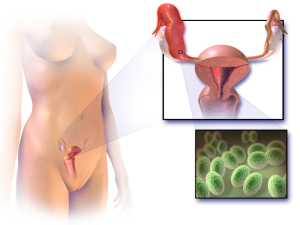[retweet][facebook]
Acupuncture combined with Chinese herbal medicine cures pelvic inflammatory disease (PID). This disorder is an infection of the female reproductive organs and may present as an acute emergency or a chronic illness. PID commonly involves infection of the uterus, fallopian tubes, or ovaries. In many cases, bacteria from the vagina or cervix transmits to these regions leading to PID. Gonorrhea and chlamydia are major causes of this disorder but there are many other causes including infections following abdominal surgery. Congealed exudate from the infection may cause salpingitis and subsequent infertility.
In China, approximately 2 million new cases of PID are reported every year. In the US, is it estimated that over 1 million women experience PID every year. The major symptoms are abdominal pain accompanied by leukorrhea, vaginal discharge.
 Researchers published their findings in the Medical Innovation of China journal. The study involved 90 patients with chronic pelvic inflammatory disease. A comparison was made between using only herbal medicine and another group receiving herbal medicine combined with acupuncture. The average age of the patients was 35 and the average symptoms duration was 1.7 years.
Researchers published their findings in the Medical Innovation of China journal. The study involved 90 patients with chronic pelvic inflammatory disease. A comparison was made between using only herbal medicine and another group receiving herbal medicine combined with acupuncture. The average age of the patients was 35 and the average symptoms duration was 1.7 years.
The herbal medicine given to patients in both groups contained:
- Dang gui 10g
- Gan Jiang 5g
- Xiao Hui Xiang 10g
- Wu Ling Zhi 5g
- Wu Zhu Yu 10g
A decoction was made and was consumed twice per day, morning and night. For patients with severe PID, the consumption rate was increased to 3 times per day. The group receiving acupuncture combined with herbal medicine received 20 minute needle retention time acupuncture sessions. The acupuncture points used for the patients were:
- Zhong Ji (CV3)
- Guan Yuan (CV4)
- Qi Hai (CV6)
- San Yin Jiao (SP6)
- Zu San Li (ST36)
- Zi Gong (extra point)
The group receiving acupuncture combined with herbal medicine had a 97.8% total effective rate. The herbal medicine only group had an 82.2% total effective rate. Only 1 patient in the acupuncture combined with herbal medicine group did not respond to treatment. In the herbal medicine only group, 8 patients did not respond to treatment. For the acupuncture combined with herbal medicine group, there was a 6.7% relapse rate. The herbal medicine only group had a 22.2% relapse rate. The researchers note that both groups showed significant improvements.
This study was a protocolized approach to care. In Traditional Chinese Medicine (TCM), acupuncture point selections and herbal formula ingredients are customized per each patient’s individual differential diagnosis. In this study, a standardized set of acupoints and herbs were selected for all patients. The protocolized approach is often used to reduce variables in the investigation.
Acupuncture combined with Chinese herbal medicine cures pelvic inflammatory disease (PID). This disorder is an infection of the female reproductive organs and may present as an acute emergency or a chronic illness. PID commonly involves infection of the uterus, fallopian tubes, or ovaries. In many cases, bacteria from the vagina or cervix transmits to these regions leading to PID. Gonorrhea and chlamydia are major causes of this disorder but there are many other causes including infections following abdominal surgery. Congealed exudate from the infection may cause salpingitis and subsequent infertility.
In China, approximately 2 million new cases of PID are reported every year. In the US, is it estimated that over 1 million women experience PID every year. The major symptoms are abdominal pain accompanied by leukorrhea, vaginal discharge.
Researchers published their findings in the Medical Innovation of China journal. The study involved 90 patients with chronic pelvic inflammatory disease. A comparison was made between using only herbal medicine and another group receiving herbal medicine combined with acupuncture. The average age of the patients was 35 and the average symptoms duration was 1.7 years.
The herbal medicine given to patients in both groups contained:
- Dang gui 10g
- Gan Jiang 5g
- Xiao Hui Xiang 10g
- Wu Ling Zhi 5g
- Wu Zhu Yu 10g
A decoction was made and was consumed twice per day, morning and night. For patients with severe PID, the consumption rate was increased to 3 times per day. The group receiving acupuncture combined with herbal medicine received 20 minute needle retention time acupuncture sessions. The acupuncture points used for the patients were:
- Zhong Ji (CV3)
- Guan Yuan (CV4)
- Qi Hai (CV6)
- San Yin Jiao (SP6)
- Zu San Li (ST36)
- Zi Gong (extra point)
The group receiving acupuncture combined with herbal medicine had a 97.8% total effective rate. The herbal medicine only group had an 82.2% total effective rate. Only 1 patient in the acupuncture combined with herbal medicine group did not respond to treatment. In the herbal medicine only group, 8 patients did not respond to treatment. For the acupuncture combined with herbal medicine group, there was a 6.7% relapse rate. The herbal medicine only group had a 22.2% relapse rate. The researchers note that both groups showed significant improvements.
This study was a protocolized approach to care. In Traditional Chinese Medicine (TCM), acupuncture point selections and herbal formula ingredients are customized per each patient’s individual differential diagnosis. In this study, a standardized set of acupoints and herbs were selected for all patients. The protocolized approach is often used to reduce variables in the investigation.
Excerpt from:
Herbal Medicine and Acupuncture Treat Pelvic Inflammatory Disease
